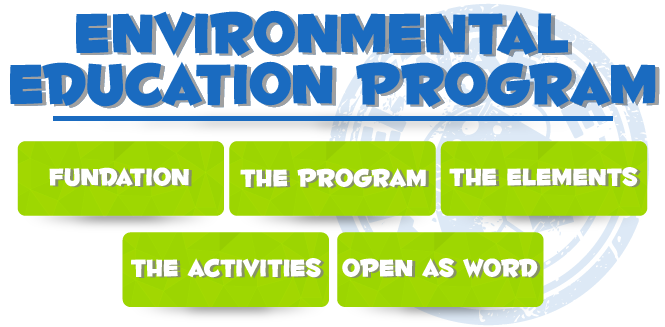| the plants |
|

|
 |
ACTIVITIES:
|
|
|
 |
| Title: 1. The lost seed |
| We Work on: |
|
-
Caring
-
Observation
-
ResponsibilY
|
| ACTIVITY DEVELOPMENT: |
| We will tell a story: |
| |
|
aul used to live in a very beautiful house that had a wonderful garden decorated with a lot of flowers. Some of those were still seeds, prepared to bloom.
One of them -we don't know how- was left out of the soil, in a place close to a fountain. The time went by, and the seed was more and more ill, because it hardly ever was watered (it only received some drops from the fountain from time to time). It was not going to grow and become a beautiful flower if it continued in the same way.
One day, while Paul was playing in the garden, he saw the seed and thought: "It would be better if I took care of this seed at home; if I do this, it will become as strong as the others". So he took a small flowerpot and put some soil in it; then he introduced the seed in it to keep it warm. Everyday, when Paul got up, the first thing he did was to water his seed. A short time later, a small green branch appeared, and it began to grow faster and faster.
Paul got up one day and his happiness was huge when he saw a small flower appearing from the green branch. The flower was smiling at him. From that day the flower was never sad again, because it knew it had a friend who took care of it and gave affection to it.
When the story is finished, the teacher will ask the children:
- Why was the seed sad?, What did Paul do when he saw it?
- What did he do to take care of the seed?, What happened some days after the seed was seen by Paul?
The teacher will give the children some fast-growing seeds. Each child will plant his/her seed and will take care of it.
|
 |
 |
|
|
| |
 |
| Title: 2. Our classroom is full of life |
| We Work on: |
|
- Caring
- Observation
- Responsibility
- Enjoyment of Nature activities
|
| ACTIVITY DEVELOPMENT: |
| Each child will bring a plant to the classroom. He/she will show the plant to his/her mates and tell them what kind of plant it is, how it needs to be cared, if it will have flowers, etc. |
|
Everybody will chose a name for his/her plant and tell the rest of the group why he/she has chosen that name.
The teacher will help the children to look for an appropriate place for the plants. He/she also will help the children to take care of the plants: they will have to water them, to observe if the plant has light enough, to root out some weeds that are born around them, etc.
In a very big mural children will draw their plants, and the teacher will write the names of the plants below the drawings. The mural will also decorate the classroom, as well as the plants |
 |
 |
|
|
| |
 |
| Title: 3. From petal to petal |
| We Work on: |
|
|
| ACTIVITY DEVELOPMENT: |
| On a very big mural or even on the ground the teacher will draw a table (see illustration) and will prepare some coloured cards (six cards of each colour). |
|
He/she will write three right actions and three wrong actions about the care of plants on each group of cards. Then he/she will order the cards according to their colours (the six cards of one colour will be together).
Children must be split up in five groups; each group must have a leader in order to represent the rest of the group. Leaders will be "tokens" of their groups. They have to stand in the first box. Each team will cast the dice in turns (the dice only represent punctuation from one to three); the leader moves forward as many boxes as the punctuation of the dice. If the leader stops in a coloured box, the teacher will read a card of that colour, and the children will have to guess if the action the teacher has read is right or wrong. If they give the right answer, they will move forward two more boxes; on the contrary, if they are wrong, they will move backward a box. Meanwhile, the rest of the members of the groups must animate their leaders. The winning team will be the one whose leader reaches first the finishing line.
Some examples about right and wrong actions:
- To root out the plants
- To step on flowers
- To observe the plants and water them if necessary
- To play with the ball amongst the flowers
- To place the plants in a breezy place of the house
- To root out the weeds of our orchard
- To fertilise the plants
P.D.: Actions on the cards must be known by the children; we will decide what to write according to the age of our pupils |
 |
 |
|
|
| |
| |
 |
| Title: 4. Mrs. Potato |
| We Work on: |
|
|
| ACTIVITY DEVELOPMENT: |
| The teacher will bring several potatoes to the classroom. He/she will show the potatoes to the children, and will let them to touch and smell the potatoes, to compare their sizes and colours, etc. |
|
Then he/she will ask:
- Who likes potatoes?
- How does your parents cook them?
- How often do you eat potatoes?
- Any of you know where the potatoes are grown up?
As you can see, potatoes are very important in our lives; everybody likes them, and there are a lot of ways to cook them.
Some experiments to observe the growth of the potatoes:
- We place a potato over a recipient full of water, in such a way that the potato is in contact with the water. Then we place the whole thing in a dark and cool place (somewhere like a wardrobe). We will have to observe the changes as the time goes by. After a few days the potato will have some roots; at this very moment we will have to plant it. A child will water it each day. If our school doesn't have a small orchard, we can plant it in a wooden drawer in the playground.
- Labyrinth: we prepare a cardboard box with a hole in the upper cover (light will enter through it). Inside the box we will built a kind of stairs made with cardboard. Inside the box, at the bottom, we will place a potato that has shoots. Each day we will observe the growth of the potato and we will notice that the small branch has grown up sorting the steps, looking for light
|
 |
 |
|
|
| |
 |
| Title: 5. Country florwers |
| We Work on: |
|
|
| ACTIVITY DEVELOPMENT: |
| Print supplementary material (click here to open) and hand it out. |
|
Colour the flower and cut it up; with a drinking straw or an ice cream stick we will make the stem.
Once the flowers are finished, the children will spread over the classroom, raising their flowers.
The teacher plays music, and the children move their flowers according to the music, as if they were moved by the wind. Some children will be "flower-cutters", and when the music stops they have to root out the flowers of the children who are around them. When the music starts again the children who still have flowers will move them, and the "flower-cutters" will move around these children. When the music stops once again, the "cutters" will root out the rest of the flowers. Then all the children will recite:
Flowers give us
life and colours.
Don't root out
the flowers please!
The "flower-cutters" will apologise and give the flowers back to their owners, kissing them. When all the children have their flowers again, all of them will dance the "flowers dance", according to the music the teachers decides to play.
P.D.: Some music we suggest: "Vivaldi: The four seasons (Spring)" or "Grieg: Dawning in Peer Green" |
 |
 |
|
|
| |
 |
| Title: 6. This plant is poisoned! |
| We Work on: |
|
|
| ACTIVITY DEVELOPMENT: |
| The teacher tells the children: |
|
The teacher tells the children:
Today our pet has told me that we have to be very careful with the food we take and with the water we drink. If the water and the soil are dirty or poisoned with polluting products, the animals and plants that live in that area can also be contaminated and, as we eat them, perhaps we can be poisoned and become ill, too.
Let's make an experiment so that you can understand better what happens.
We need:
-
A glass of water
-
Some watercolours or colouring matter
-
A branch of cele
Each child will drop some watercolour or colouring into his/her glass of water. Then everybody will introduce the celery into the water too. At the end of he day we will observe what has happened.
The celery has changed its colour because it has drunk the contaminated water. Now it is also contaminated.
If we dump garbage into the rivers and lakes, the water will become poisoned and it will poison the plants and animals that drink it |
 |
 |
|
|
| |
|
| |
 |
| Title: 7. My tree´s diary |
| We Work on: |
|
|
| ACTIVITY DEVELOPMENT: |
| Each child must pay attention to a tree he/she can observe very often (a tree in the school, in his/her house or in any place he/she has contact with). |
|
They also have to investigate what is its name and add something else to the name; for example: happy apple tree or Peter pear tree, ...
They have to have a folder, in which they can keep all the information they get about "their" trees:
- A drawing of it
- A drawing of its fruits or seeds
- A leaf of the tree glued on a thin cardboard
- The "print" of the tree: place a paper leaf over the bark of the tree, and rub it with a crayon.
Throughout all the year the children have to observe the variations the tree is undergoing and draw them.
Each child will tell his/her mates what he/she has found out about the tree and lend his/her folder to the rest of the group in order they can also learn about that tree.
P.D.: The eldest children can write a poem about the tree and keep it in the folder. Teachers must help them to write it |
 |
 |
|
|
| |
 |
| Title: 8. The plants of my aread |
| We Work on: |
|
|
| ACTIVITY DEVELOPMENT: |
| In all the corners of our planet you can find different kinds of plants; it's very important that we know and protect the original plants in our area. |
|
We will ask the children to observe and draw the plants, when we go on a excursion (to a forest, to the mountain, to the countryside, ...).
Once in the classroom again we will prepare a big mural about the plants. Parents will have to help us:
- What's the name of each plant?
- How can we take care of them?
- What can we obtain from them?
If we have the necessary means, the teacher can prepare an area for typical local plants in the playground. He/she will also prepare a "duty schedule" for the children to take care of those plants.
If possible, we will take pictures of the plants and we will glue them on the mural, beside their names and all the information about them |
 |
 |
|
|
| |
 |
| Title: 9. Guess how I take care of it |
| We Work on: |
|
|
| ACTIVITY DEVELOPMENT: |
| The teacher will print form the supplementary material - click to open in a new window: document 1, document 2 y document 3) the pictures about right and wrong actions about the care for plants |
|
He/she will give each child a model. Children will have to observe the illustrations. The teacher will show them each one of the situations and the children will observe them and say if these situations are good or bad ones.
The pupils will form several groups of six children each. Each group will have two chairs, one chair separated about 5 meters from the other one. The children of each group will make a line behind one of the chairs; on the other chair we will leave as many illustrations as children forming the group. Illustrations must be about the positive situations you have been commenting on before (it doesn't matter if some of the pictures are repeated).
When the teacher says, the first child of each line will run to the second of the chairs of the group. He/she will take one picture and imitate what appears on it; the rest of the group must guess what action is his/her mate miming. Once the group has guessed the action, the child who ran will come back to the line and touch the shoulder of the first of the members of his/her group. Then, this new child will have to do what his/her mate did before. The group that finishes the first will be the winner.
When the game is over the cards that show positive actions will be glued on the mural of the classroom; in this way, everybody will remember them everyday.
P.D.: With young children only one group can be formed; we will leave as many cards as children playing. All of them will be winners. |
 |
 |
|
|
| |
 |
| Title:
10. Vegetables |
| We Work on: |
|
|
| ACTIVITY DEVELOPMENT: |
| Each child must bring some food obtained from a plant; besides, he/she has to bring a drawing of the plant and a easy recipe we can prepare with that food (if we are working with young children we will write a note to their parents asking them to collaborate with their children on the drawing and the recipe). |
|
Each child will show the rest of the group the food and the drawing he/she has brought, while saying its name.
The teacher will ask the children about:
- The different dishes that can be prepared with them.
- How do their parents prepare those foods?
- What are their favourite ways to eat them?
- If there is any item they don't like amongst the ones they have brought.
The teacher will comment on the importance of the plants as food for us and also on the benefits we can obtain from them.
The children will make a book about vegetables. Of course, the teacher will help them:
- Glue each drawing on one page of the book and write the name of the plant.
- The teacher will help them to write the recipes; they can add some illustrations or drawings to it.
- Glue some pictures of vegetables that appear in magazines or catalogues from supermarkets.
- Decorate the covers of the book with printings from the food they have brought (they have to be damped in watercolours for this
|
 |
 |
|
|
| |
 |
| Title: 11. Don´t be sad |
| We Work on: |
|
-
Observation
-
Initiative
-
Defence
|
| ACTIVITY DEVELOPMENT: |
| The teacher shows the children a flower that is shrivelled. Then he/she asks them why do they think that flower is in that condition. |
|
rint the supplementary material (click here to open), and give one illustration to each child. When they have observed the picture, ask them:
- What can you see in the picture?
- Which flowerpot is your favourite?
- What has happened to this flower? (Pointing to the one without petals).
- Why doesn't it have any petals?
- What would we have to do to keep this flower as strong and healthy as the other one?
- Don't you think it's sad? Why don't we draw its petals and colour them?
At this moment the children draw the petals and colour them.
The children paint their hands with green watercolour and they stamp their handprints on a mural, as if the prints were grass.
Cut the flowerpots with the flowers and glue them over the grass on the mural.
The children observe the classroom and decide which place in it is the saddest. That place will be the one in which you must hang the mural, to give it happiness and colour
|
 |
 |
|
|
| |
 |
| Title: 12. The orchard |
| We Work on: |
|
- Caring
- Respect
- Initiative in nature preservation
- Enjoyment of nature activities
|
| ACTIVITY DEVELOPMENT: |
| In the right place of the playground we will build an orchard (that place has to receive as many hours of sun as possible and be protected from cold and humid winds). |
|
Delimit the area with fences or with sticks and strings, in order to avoid stepping on it. Both, teacher and children will decide what kind of plants they are going to plant in each season of the year. They will also decide about the responsibilities of caring for the garden.
Prepare the land, clean it from weeds, garbage and stones; turn over the land to ventilate and soften it. Improve the water drainage. When the land is dry, break the clods into small pieces, mixing the land with the fertiliser (just in case you have used it).
Prepare some mounds on the land with trails on the sides intended for the water to drain and for walking on them when cultivating. If possible, put some carpet squares on them. Prepare orchard seeds, of which eatable parts are obtained from:
- The root (potatoes, carrots, onions, garlic, …)
- The leaf (lettuces, silver-beets, …)
- The flower (tomatoes, peppers, …)
Each group will prepare and sow a type of plants; they will also elaborate some cards with the drawing of the plants that have been sowed and place them on the seedbeds, to distinguish those seeds from the rest. According to the plan, the children will water the area, they will root out some weeds, etc.
hen you recollect the products, the children will bring them home.
P.D.: If there is no chance to build an orchard, seeds can be sowed in big wooden drawers (one plant in each drawer |
 |
 |
|
|
| |
 |
| Title: 13. Plants give us ... |
| We Work on: |
|
|
| ACTIVITY DEVELOPMENT: |
| The children are sat down in a circle. The teacher says: |
|
Plants need us and we need them.
ou may think plants don't need any kind of care, but they really do. They, as we do, can fall ill. How?:
- If they don't receive water
- If they receive too much water
- If they don't have enough soil
- Some insects attack them
- Pollution provokes their death
- If they don't have enough light to grow up, etc…
If we take care of them they will give us plenty of things we need; besides they decorate our houses and gardens and offer us their beauty.
Which things do the plants give us?
- Wood: to build houses, pieces of furniture, paper,…
- Cotton and clothes: to make dresses, sheets, tablecloths, blankets,…
- Sweets: liquorice, vanilla, spearmint, popcorn, ….
- Medicines: camomile for the stomach-ache, syrup for the cough, …
- They clean the air we breathe
- Food: for the animals (cows, sheep, bees, …)
- Dyes: to make colours
- Smells: to make perfumes.
Now we know plenty of things about what plants give us, so let's draw and glue some products from plants on a mural.
The teacher asks the children to bring some products from plants; these products can be in its natural state or some images or pictures from magazines, newspapers, ... (a piece of wood, cotton, different papers, some thread, popcorn...).
When the children bring the different material from home, they show them to their mates and glue them on the mural
|
 |
 |
|
|
| |
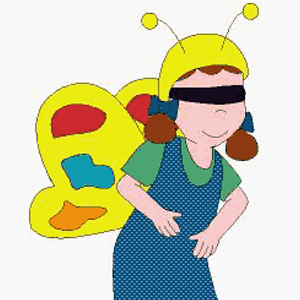 |
| Title: 14. Yummy! |
| We Work on: |
|
|
| ACTIVITY DEVELOPMENT: |
| Butterflies, bees and other kind of insects like the plants because these bugs obtain their food from them (nectar from flowers is a very appreciated food item). |
|
Some children are flowers and the others are insects. Insects (who have their eyes covered with a handkerchief or something similar) have to look for the flowers. Flowers imitate the sound of a bell to help the insects to find them.
When insects find the flowers they will stand beside them. When all the insects find a flower everybody holds hands, making a circle.
Each child, according to his/her place in the circle, will tell his/her mates which flower he/she would like to be, what colour would the flower be and why, where he/she would like to be and how he/she would like to be treated from the people who would visit him/her
|
 |
 |
|
|
| |
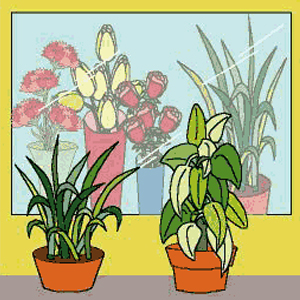 |
| Title: 15. Plant shop |
| We Work on: |
|
-
Caring
-
Observation
-
Respect
|
| ACTIVITY DEVELOPMENT: |
| Visit a plant shop or a tree nursery. |
|
If you can't visit any of these places perhaps a market can work; a lot of times we can find some markets-stalls with plants and flowers in them.
When you are there, you must ask the person in charge about the plants he/she has, which ones of them must be indoors, which ones have deciduous leaves, which ones have leaves all the year long, what cares they need, etc.
Once in the classroom again, you will prepare a plant shop with the children:
Form groups of about five or six children each. Each group will lead one stand. The members of each group will make flowerpots with several kinds of plants with play dough of different colours. Some plants will have flowers, some of them will be cactus (we can use toothpicks for this), and some others will have only leaves...
Another option is to look for pictures and illustrations of plants in magazines, cut them up and glue them on thin cardboard. The children will write the name of the plants beside the correspondent picture and decide about the kind of care all the plants need. Then they will put the murals on the table as if it was a shop window.
All the children will "go shopping" to all the stands and they will ask the "employees" about the names of the plants, the care they need, etc
|
 |
 |
|
|
| |
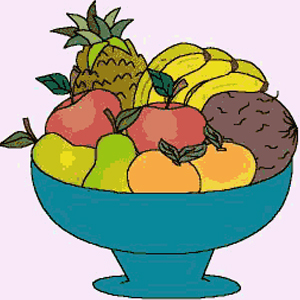 |
| Title: 16. I like this fruit salad! |
| We Work on: |
|
|
| ACTIVITY DEVELOPMENT: |
| We will ask the children to bring a piece of fruit from home. |
|
Each child will show the rest of the class the fruit he/she has brought and say its name.
The children will smell the different fruits and they will compare their sizes and their texture. We will ask them if the know which fruits come from a plant and which ones come from trees, etc.
The teacher will talk about the importance of the fruits in our lives. And this will be another reason to take care and respect the plants.
The children will wash their hands, and they will help the teacher to peel all the fruits and to cut them in small pieces. They will taste a small piece of each fruit; with the rest of the pieces they will prepare a fruit salad.
The teacher will ask some children to go to the kitchen of the school to ask for plastic glasses or bowls and some teaspoons.
When everybody is in the classroom again, some children will serve the fruit salad for all of them.
When they finish their salad they will clean the bowl and the teaspoon they have been using and will give them back to the cook saying to him/her "thank you"
|
 |
 |
|
|
| |
 |
| Title: 17. The herbalist´s shop |
| We Work on: |
|
|
| ACTIVITY DEVELOPMENT: |
| Before doing the activity with the children we have to ensure that we have a dryer press; it can be built by the teacher or by any volunteer parent. |
| |
|
Only two wooden panels and some long screws and wingnuts will be needed. The panels will have small holes to introduce through them the screws, which will be seized with the wingnuts (similar to the picture).
Children will pick up some leaves, flowers and plants in an excursion we organise.
The teacher must point out to the children that they only have to take one leaf of each type and must try not to hurt the plants (they don't have to root out the plants). The teacher will bring some cloth bags in which the children will keep the leaves and flowers they have picked up.
t's the moment to star with the sheen. First of all we will compile information about the plants we have some samples from: their names, what kind of plants they are (a tree, a bush or grass), etc.
The children will put the different samples on the press, separating one from each other with absorbent paper (we can also use pages from a newspaper). When we have all the samples in the right place, we will press them and put them in a dry place.
From time to time the children check the state of the samples, changing the pieces of paper if necessary. When they are dry, we will glue them on a mural, where we will also write their names. The children will colour the distinguishing mark according to the plant origin (print supplementary material: click here to open in a new window). When we have all the information ready, we will protect the mural with some transparent paper.
|
 |
 |
|
|
| |
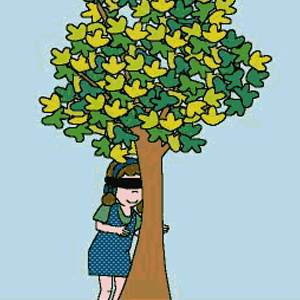 |
| Title: 18. Guess the tree |
| We Work on: |
|
|
| ACTIVITY DEVELOPMENT: |
| We will be in the playground or in a close park to carry out this activity. There must be several trees or plants that can be explored by the children. |
|
The children will work in couples. One of the members of the couple will be the guide, and the other one will be the "blind person" he/she will have his/her eyes covered with a handkerchief or something like that).
The guide will lead his/her mate through the park or playground to a place where there is any tree or plant.
The "blind child" will explore the tree with his/her hands and try to figure out how it is. When he/she thinks it's enough, the guide will lead him/her again to the starting point. Then the "blind child" uncovers his/her eyes and observes the trees (or the plants) and tries to guess which one has been the tree he/she has been exploring.
Now the guide becomes "blind child" and vices versa. When both have recognised their trees, they will draw them and glue the drawings on the mural of the classroom. The children will observe the tree all the year long; if the tree suffers any modification the children will have to draw it again and put the new picture beside the old one. In this way they will learn about the different periods the tree goes through |
 |
 |
|
|
| |
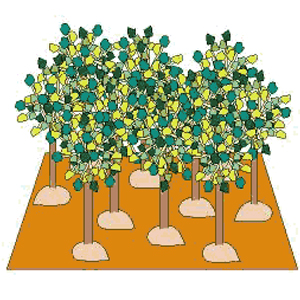 |
| Title: 19. Save the forest! |
| We Work on: |
|
|
| ACTIVITY DEVELOPMENT: |
| The teacher tells the children a story. The situation takes place in a forest (he/she can show them a picture of a forest in which they can see a lot of plants and trees): |
|
Trees live in the forests; and some insects, birds, snakes, mice, squirrels... live in the trees. Trees are their home.
Besides, a lot of necessary products are obtained from the trees. We can get wood to build houses from them, pieces of furniture, pencils, paper, resin to make glue... But we can't cut down the trees without rhyme or reason. Do you remember when we formed the Club that I told you that the Earth was ill because the trees were being cut and burned and because the entire planet was very dirty? That can't continue in this way.
You also have to know that trees are "wizards"; they convert the dirty air in clean one. Besides, if the woods and forests are destroyed, all the species that live in there will disappear too.
Let's build our forest!
Each child will make a small ball with play dough; he/she will put a ice-cream stick on it. Insert another play dough ball in the upper part, and some toothpicks pricked around it. The child will also cut some pieces of coloured paper and glue them on the picks as if they were leaves.
Everybody will place his/her tree over a wooden or cardboard panel (pressing on the small ball to keep the tree standing).
Put the scale model in a central place in order that all the children can see it. All of them will have to decide a name for their forest.
P.D.: If possible, this activity should be carried out in all the classes at the same time; in this way, we will be able to prepare a small exposition when all the forests are ready
|
 |
 |
|
|
| |
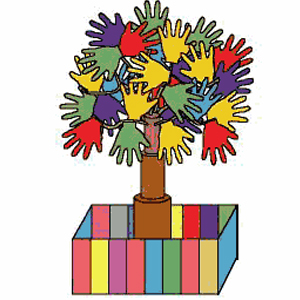 |
| Title: 20. The day of the tree (The joined hand tree) |
| We Work on: |
|
-
Collaboration
-
Caring
-
Defence
|
| ACTIVITY DEVELOPMENT: |
| The teacher will say to the children:
|
|
Today we are going to build a tree, which will be formed with all our hands. The leaves symbolise our hands; hands that are joined and that work together to protect the environment.
These are the steps to follow:
- Pick up some dried branches or ask the children to bring them from home.
- Prepare cardboard cylinders for the children to colour them.
- Once the cylinders are coloured, put them one beside each other, forming a block. If they have different diameters, place them from the one that has the widest diameter to the one with the shortest one.
- Make holes in the cylinders and introduce the dried branches or some sticks trough them, as if they were the branches of a tree.
- Give to each child the silhouettes of the leaves (click here to open in a new window).
- Put the tree in a cardboard box as if it was a flowerpot.
- Write the name of the child who has made the leaf on it.
The children are split up into small groups. Each group will colour the cylinders in brown (they will form the trunk of the tree). They will also colour the leaves (they can print them with their hands, using watercolours) and cut them up. Finally, they will glue the leaves on the tree branches, folding them by the central part.
Each child will colour a section of the flowerpot in a different colour to decorate it.
When all the process is finished, everybody will form a circle around the tree, hold their hands and sing a song to celebrate the creation of the day: the day of the joined hands tree
|
 |
 |
|
|
| |
| |
| |
| |
| |
| |
|
 |


